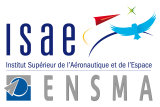2nd International Conference on Model & Data Engineering (MEDI’2012)
October 3 - 5 2012
Poitiers, Futuroscope - France
http://medi2012.ensma.fr
 |
 |
 |
 |
| Wednesday (October 03, 2012) | |
| 11h00 - 12h00 | Registration and Welcome (ENSMA) |
| 12h00 - 14h00 | Lunch |
| 14h00 - 15h00 | Keynote 1 Cloud Blueprint: A Model-driven Approach to Configuring Federated Clouds, Mike P. Papazoglou, Tilburg University, the Netherlands |
| 15h00 - 15h30 | Coffee Break |
| 15h30 - 17h30 | Session 1: Model Driven Engineering, Modelling Languages, Meta-modelling, Model Transformation, Model Evolution (I) |
|
|
| 19h00 - ... | Social Program |
| Thrusday (October 04, 2012) | |
| 9h00 - 10h00 | Keynote 2 Model-based Auto Coding of Embedded Control Software with full Semantics, by Eric Féron, Georgia Institute of Technology, Atlanta, Georgia, USA |
| 10h00 - 10h30 | Coffee Break |
| 10h30 - 12h30 | Session 2: Model Driven Engineering, Modelling Languages, Meta-modelling, Model Transformation, Model Evolution (II) |
|
|
| 12h30 - 14h00 | Lunch |
| 14h00 - 15h30 | Session 3: Ontology Based Modelling, Role of Ontologies in Modelling Activities |
|
|
| 15h30 - 16h00 | Coffee Break |
| 16h00 - 17h00 | Session 3: Ontology Based Modelling, Role of Ontologies in Modelling Activities |
|
|
| 19h00 - ... | Exotic Gala Dinner |
| Friday (October 05, 2012) | |
| 9h00 - 10h00 | Keynote 3 Development and use of ontologies in the engineering domain, by Eric Sardet, CRITT Informatique, Poitiers Futuroscope, France |
| 10h00 - 10h30 | Coffee Break |
| 10h30 - 12h30 | Session 4: Miscelanea |
|
|
| 12h30 - 12h45 | Closing |
Mike P. Papazoglou (Tilburg University, The Netherlands)
Current cloud solutions are fraught with problems. They introduce a monolithic cloud stack that imposes vendor lock-in and donot permit developers to mix and match services freely from diverse cloud service tiers and configure them dynamically to address application needs..
Cloud blueprinting is a novel model-driven approach that allows developers syndicate, configure, and deploy virtual service-based application payloads on virtual machine and resource pools in the cloud. Cloud blueprinting helps developers automatically provision services, effectively manage workload segmentation and portability (i.e., the seamless movement of workloads across many platforms and clouds), and manage virtual service instances, all while taking into account the availability of cloud resources and accelerating the deployment of new composed cloud services. Cloud blueprinting equips developers with a unified approach that allows them configure cloud applications by pooling appropriate resources at any layer of the cloud stack - irrespectively whether these are provided from multiple cloud providers.
Eric Féron (Georgia Institute of Technology, Atlanta, Georgia)
Control software is one of the most important elements of safety-critical systems, whether it is used in aerospace, automotive, naval or medical engineering. Control software is used, for example, to regulate the altitude of an aircraft, the speed of an automobile, the heading of a ship or the intensity of an ion beam.
The design of modern embedded software requires that its functional and non functional semantics, including those of the entire system, be expressed clearly within the software to support its correctness at all levels of its implementation. Such semantics must be expressed in languages adapted to the different levels of software implementation and the systems they interact with. Therefore, block diagrams used by control theorists must also be able to support semantic properties, such as stability and performance, and their proofs. Software implementations of these block diagrams must be, correspondingly, fully documented with the same properties and their proofs, in such a way that they can be automatically parsed and verified.
An international team of researchers from ENSEEIHT, Georgia Tech, NASA, the National Institute of Aerospace, ONERA, Rockwell-Collins, SRI, and the University of Coruna, has engaged in designing the proof-of-concept for an autocoding environment for control software, where the strengths of control theory are combined with advanced specification languages. As input, the autocoder takes the block diagram of a control systems and its semantics. As output, the autocoder produces a C code, together with the controller semantics expressed in ACSL (ANSI C Specification Language). The ACSL comments, together with the C code, can be verified independently, as demonstrated by a prototype back-end also designed by the research team. Current experiments and demonstrations include the autocoding of increasingly complex control laws for a three degree-of-freedom educational device that mimics a helicopter. Other experiments include autocoding of control laws for a model F-18 jet fighter.
Although significant work has been done already, many issues need addressing to transform the prototype into a fully functional tool, including properly addressing real/foat mismatch issues.
Eric Sardet (CRITT Informatique, Poitiers Futuroscope, France)
Heterogeneous database integration, intelligent document retrieval and even natural language processing are among the numerous computer science problems that could benefit from the capability to explicitly represent themeaning of things whatever be the context in which those things are intended to be used. Models, called domain ontologies, carry out the explicit representation of knowledge.
The goal of this presentation is to underline the role of domain ontologies for data integration in an engineering context.
We first present the needs of explicit knowledge representation in the engineering domain. We then introduce the domain ontology model dedicated to this knowledge representation, the PLIB (ISO 13584 Parts Library) data model and we explain the development process of domain ontologies. On the base of these elements, we show how domain ontologies may be used in order to achieve the data integration process in the engineering domain. Finally, we discuss some industrial implementations of this engineering data integration approach.
Eric Sardet got his PhD in Computer Science at Poitiers University in 1999. Before joining CRITT (high tech company located at Poitiers, France) as project manager, he spent several years as lecturer at Poitiers University, France and high tech companies as project manager and consultant. Eric Sardet participated actively in editing PLIB ontology model normalized by ISO (ISO-13584). His research interests include: ontology engineering, ontology-based databases, data integration, and data exchange.





